Business Report: Analyzing Sainsbury's Marketing Strategies for Growth
VerifiedAdded on 2021/10/11
|11
|2201
|93
Report
AI Summary
This business report provides a comprehensive analysis of Sainsbury's current market position and recommends marketing strategies for the next three years. The report begins with an introduction highlighting the changing consumer behavior due to economic pressures and the need for Sainsbury's to adapt. It then presents an external PESTLE analysis, examining political, economic, social, technological, legislative, and environmental factors affecting the company. Following this, a SWOT analysis is conducted, identifying Sainsbury's strengths, weaknesses, opportunities, and threats. Based on these analyses, the report suggests four SMART marketing objectives: global expansion, enhanced international market knowledge, improved inventory management, and increased technology vigilance. Two key marketing strategies are recommended: differentiation (focusing on competitive pricing, product reliability, quality, and customer service) and diversification (both internal and external). The report concludes with a detailed marketing action plan, including promoting Sainsbury's as a socially responsible company, setting affordable prices, offering new products, international expansion, and potential acquisitions or mergers. The report references various sources to support its findings and recommendations.
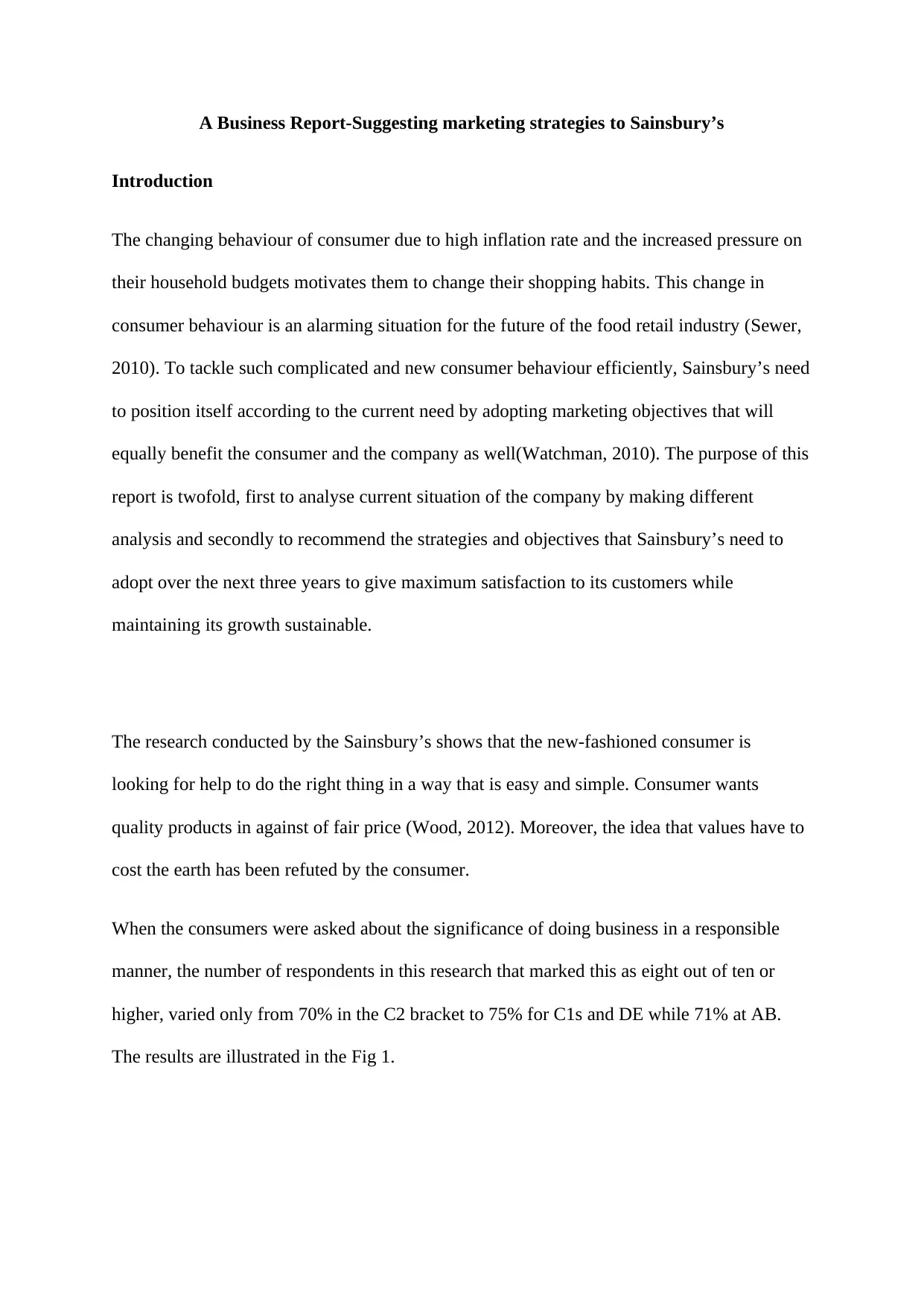
A Business Report-Suggesting marketing strategies to Sainsbury’s
Introduction
The changing behaviour of consumer due to high inflation rate and the increased pressure on
their household budgets motivates them to change their shopping habits. This change in
consumer behaviour is an alarming situation for the future of the food retail industry (Sewer,
2010). To tackle such complicated and new consumer behaviour efficiently, Sainsbury’s need
to position itself according to the current need by adopting marketing objectives that will
equally benefit the consumer and the company as well(Watchman, 2010). The purpose of this
report is twofold, first to analyse current situation of the company by making different
analysis and secondly to recommend the strategies and objectives that Sainsbury’s need to
adopt over the next three years to give maximum satisfaction to its customers while
maintaining its growth sustainable.
The research conducted by the Sainsbury’s shows that the new-fashioned consumer is
looking for help to do the right thing in a way that is easy and simple. Consumer wants
quality products in against of fair price (Wood, 2012). Moreover, the idea that values have to
cost the earth has been refuted by the consumer.
When the consumers were asked about the significance of doing business in a responsible
manner, the number of respondents in this research that marked this as eight out of ten or
higher, varied only from 70% in the C2 bracket to 75% for C1s and DE while 71% at AB.
The results are illustrated in the Fig 1.
Introduction
The changing behaviour of consumer due to high inflation rate and the increased pressure on
their household budgets motivates them to change their shopping habits. This change in
consumer behaviour is an alarming situation for the future of the food retail industry (Sewer,
2010). To tackle such complicated and new consumer behaviour efficiently, Sainsbury’s need
to position itself according to the current need by adopting marketing objectives that will
equally benefit the consumer and the company as well(Watchman, 2010). The purpose of this
report is twofold, first to analyse current situation of the company by making different
analysis and secondly to recommend the strategies and objectives that Sainsbury’s need to
adopt over the next three years to give maximum satisfaction to its customers while
maintaining its growth sustainable.
The research conducted by the Sainsbury’s shows that the new-fashioned consumer is
looking for help to do the right thing in a way that is easy and simple. Consumer wants
quality products in against of fair price (Wood, 2012). Moreover, the idea that values have to
cost the earth has been refuted by the consumer.
When the consumers were asked about the significance of doing business in a responsible
manner, the number of respondents in this research that marked this as eight out of ten or
higher, varied only from 70% in the C2 bracket to 75% for C1s and DE while 71% at AB.
The results are illustrated in the Fig 1.
Paraphrase This Document
Need a fresh take? Get an instant paraphrase of this document with our AI Paraphraser
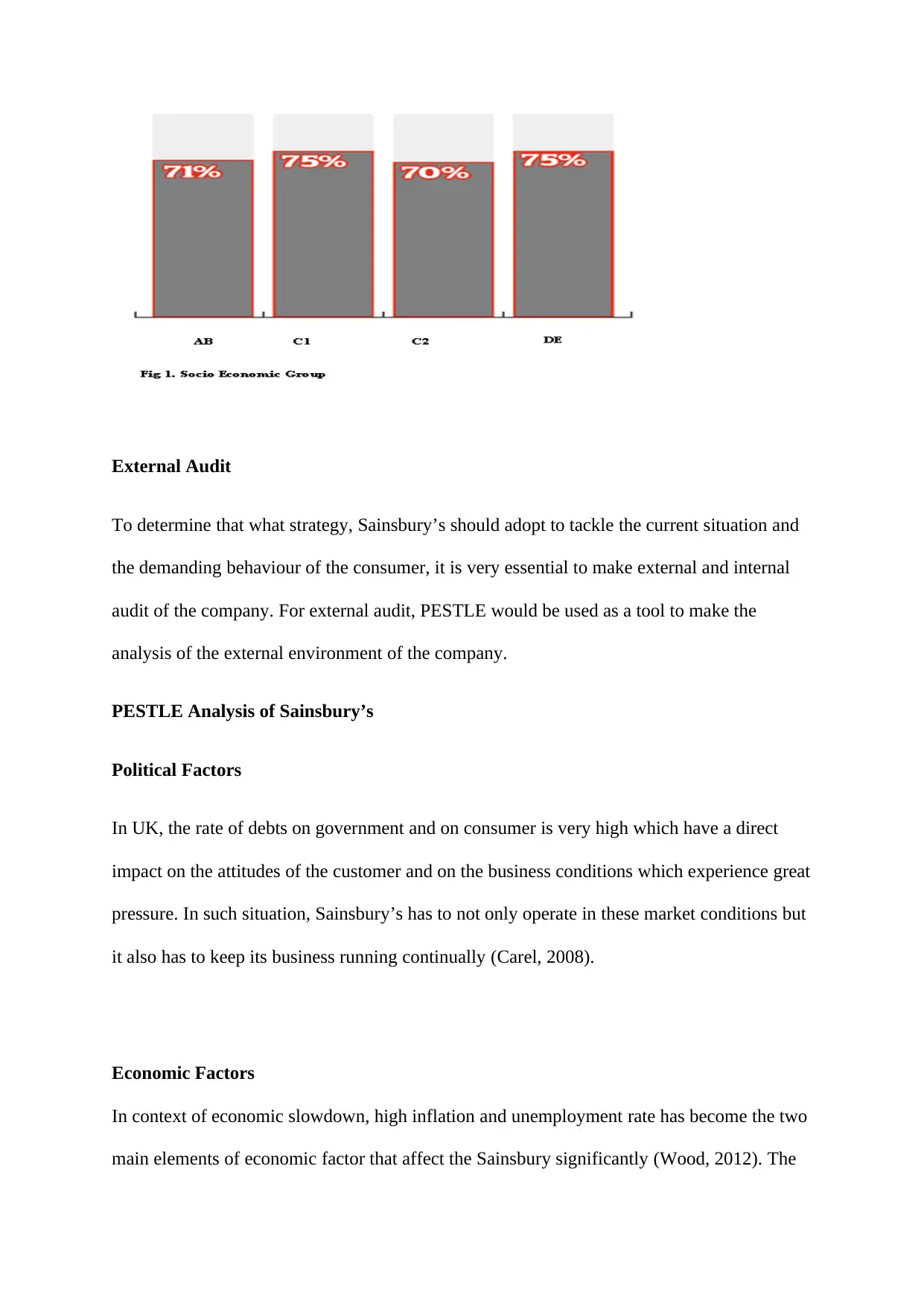
External Audit
To determine that what strategy, Sainsbury’s should adopt to tackle the current situation and
the demanding behaviour of the consumer, it is very essential to make external and internal
audit of the company. For external audit, PESTLE would be used as a tool to make the
analysis of the external environment of the company.
PESTLE Analysis of Sainsbury’s
Political Factors
In UK, the rate of debts on government and on consumer is very high which have a direct
impact on the attitudes of the customer and on the business conditions which experience great
pressure. In such situation, Sainsbury’s has to not only operate in these market conditions but
it also has to keep its business running continually (Carel, 2008).
Economic Factors
In context of economic slowdown, high inflation and unemployment rate has become the two
main elements of economic factor that affect the Sainsbury significantly (Wood, 2012). The
To determine that what strategy, Sainsbury’s should adopt to tackle the current situation and
the demanding behaviour of the consumer, it is very essential to make external and internal
audit of the company. For external audit, PESTLE would be used as a tool to make the
analysis of the external environment of the company.
PESTLE Analysis of Sainsbury’s
Political Factors
In UK, the rate of debts on government and on consumer is very high which have a direct
impact on the attitudes of the customer and on the business conditions which experience great
pressure. In such situation, Sainsbury’s has to not only operate in these market conditions but
it also has to keep its business running continually (Carel, 2008).
Economic Factors
In context of economic slowdown, high inflation and unemployment rate has become the two
main elements of economic factor that affect the Sainsbury significantly (Wood, 2012). The
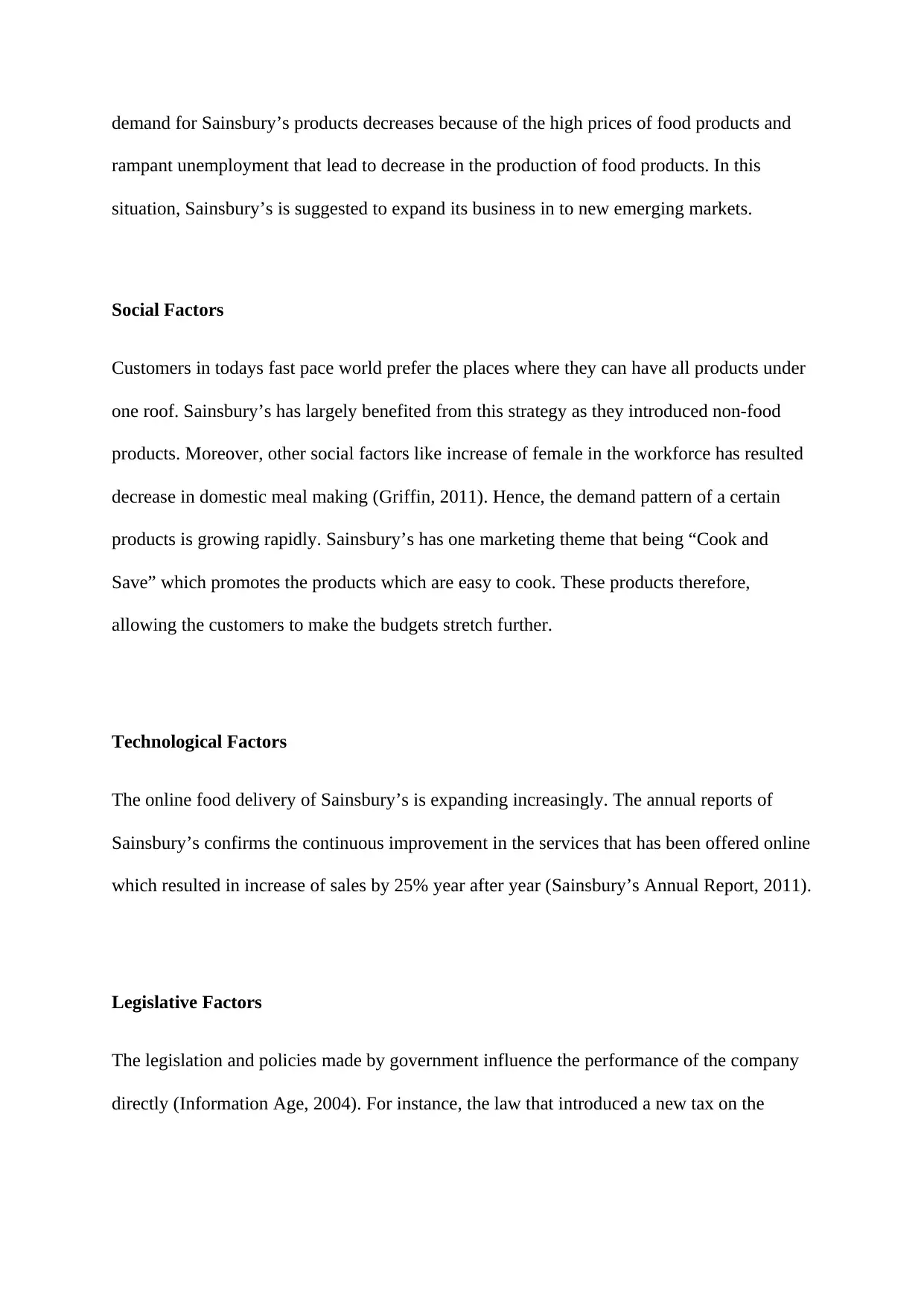
demand for Sainsbury’s products decreases because of the high prices of food products and
rampant unemployment that lead to decrease in the production of food products. In this
situation, Sainsbury’s is suggested to expand its business in to new emerging markets.
Social Factors
Customers in todays fast pace world prefer the places where they can have all products under
one roof. Sainsbury’s has largely benefited from this strategy as they introduced non-food
products. Moreover, other social factors like increase of female in the workforce has resulted
decrease in domestic meal making (Griffin, 2011). Hence, the demand pattern of a certain
products is growing rapidly. Sainsbury’s has one marketing theme that being “Cook and
Save” which promotes the products which are easy to cook. These products therefore,
allowing the customers to make the budgets stretch further.
Technological Factors
The online food delivery of Sainsbury’s is expanding increasingly. The annual reports of
Sainsbury’s confirms the continuous improvement in the services that has been offered online
which resulted in increase of sales by 25% year after year (Sainsbury’s Annual Report, 2011).
Legislative Factors
The legislation and policies made by government influence the performance of the company
directly (Information Age, 2004). For instance, the law that introduced a new tax on the
rampant unemployment that lead to decrease in the production of food products. In this
situation, Sainsbury’s is suggested to expand its business in to new emerging markets.
Social Factors
Customers in todays fast pace world prefer the places where they can have all products under
one roof. Sainsbury’s has largely benefited from this strategy as they introduced non-food
products. Moreover, other social factors like increase of female in the workforce has resulted
decrease in domestic meal making (Griffin, 2011). Hence, the demand pattern of a certain
products is growing rapidly. Sainsbury’s has one marketing theme that being “Cook and
Save” which promotes the products which are easy to cook. These products therefore,
allowing the customers to make the budgets stretch further.
Technological Factors
The online food delivery of Sainsbury’s is expanding increasingly. The annual reports of
Sainsbury’s confirms the continuous improvement in the services that has been offered online
which resulted in increase of sales by 25% year after year (Sainsbury’s Annual Report, 2011).
Legislative Factors
The legislation and policies made by government influence the performance of the company
directly (Information Age, 2004). For instance, the law that introduced a new tax on the
⊘ This is a preview!⊘
Do you want full access?
Subscribe today to unlock all pages.

Trusted by 1+ million students worldwide
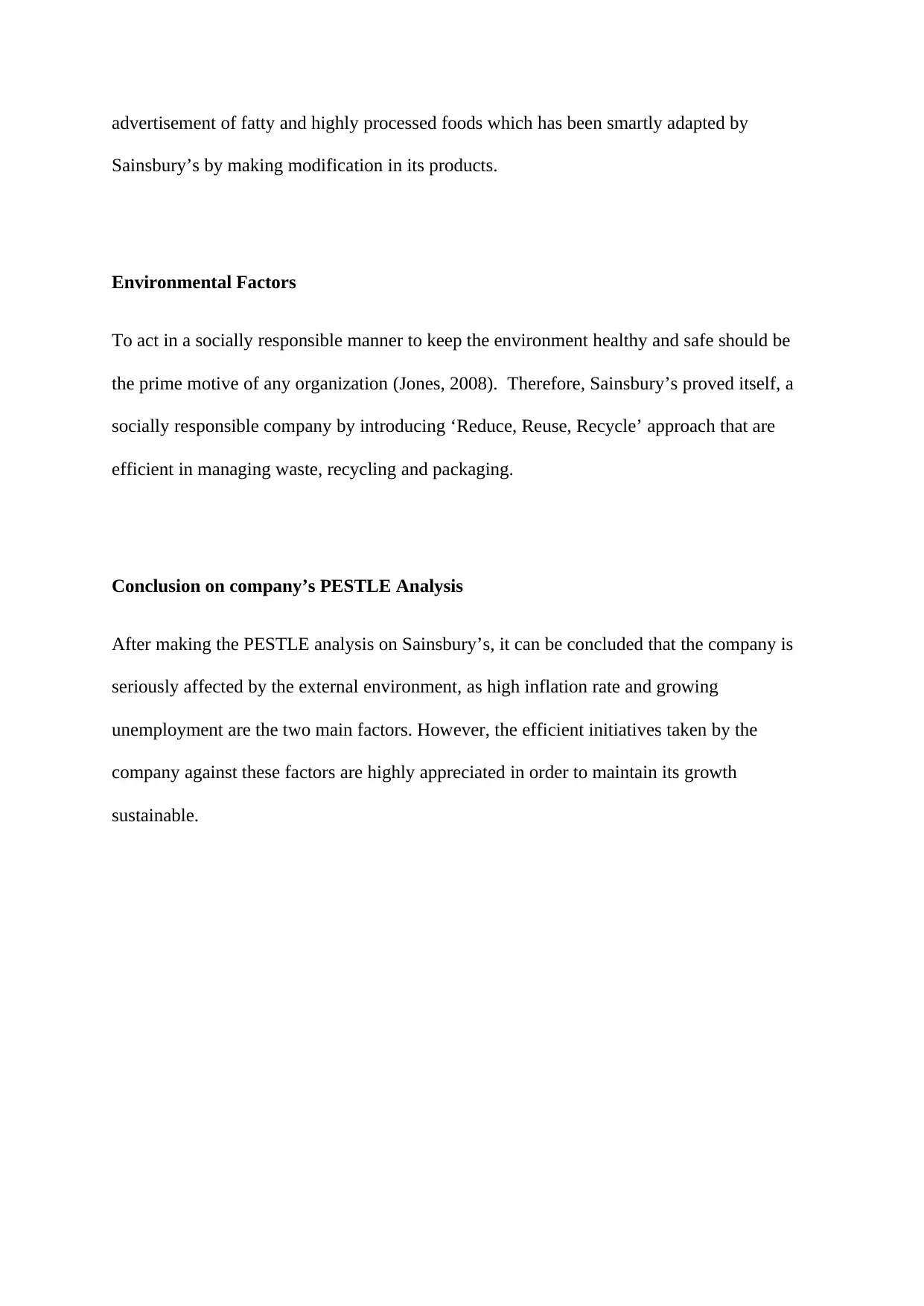
advertisement of fatty and highly processed foods which has been smartly adapted by
Sainsbury’s by making modification in its products.
Environmental Factors
To act in a socially responsible manner to keep the environment healthy and safe should be
the prime motive of any organization (Jones, 2008). Therefore, Sainsbury’s proved itself, a
socially responsible company by introducing ‘Reduce, Reuse, Recycle’ approach that are
efficient in managing waste, recycling and packaging.
Conclusion on company’s PESTLE Analysis
After making the PESTLE analysis on Sainsbury’s, it can be concluded that the company is
seriously affected by the external environment, as high inflation rate and growing
unemployment are the two main factors. However, the efficient initiatives taken by the
company against these factors are highly appreciated in order to maintain its growth
sustainable.
Sainsbury’s by making modification in its products.
Environmental Factors
To act in a socially responsible manner to keep the environment healthy and safe should be
the prime motive of any organization (Jones, 2008). Therefore, Sainsbury’s proved itself, a
socially responsible company by introducing ‘Reduce, Reuse, Recycle’ approach that are
efficient in managing waste, recycling and packaging.
Conclusion on company’s PESTLE Analysis
After making the PESTLE analysis on Sainsbury’s, it can be concluded that the company is
seriously affected by the external environment, as high inflation rate and growing
unemployment are the two main factors. However, the efficient initiatives taken by the
company against these factors are highly appreciated in order to maintain its growth
sustainable.
Paraphrase This Document
Need a fresh take? Get an instant paraphrase of this document with our AI Paraphraser
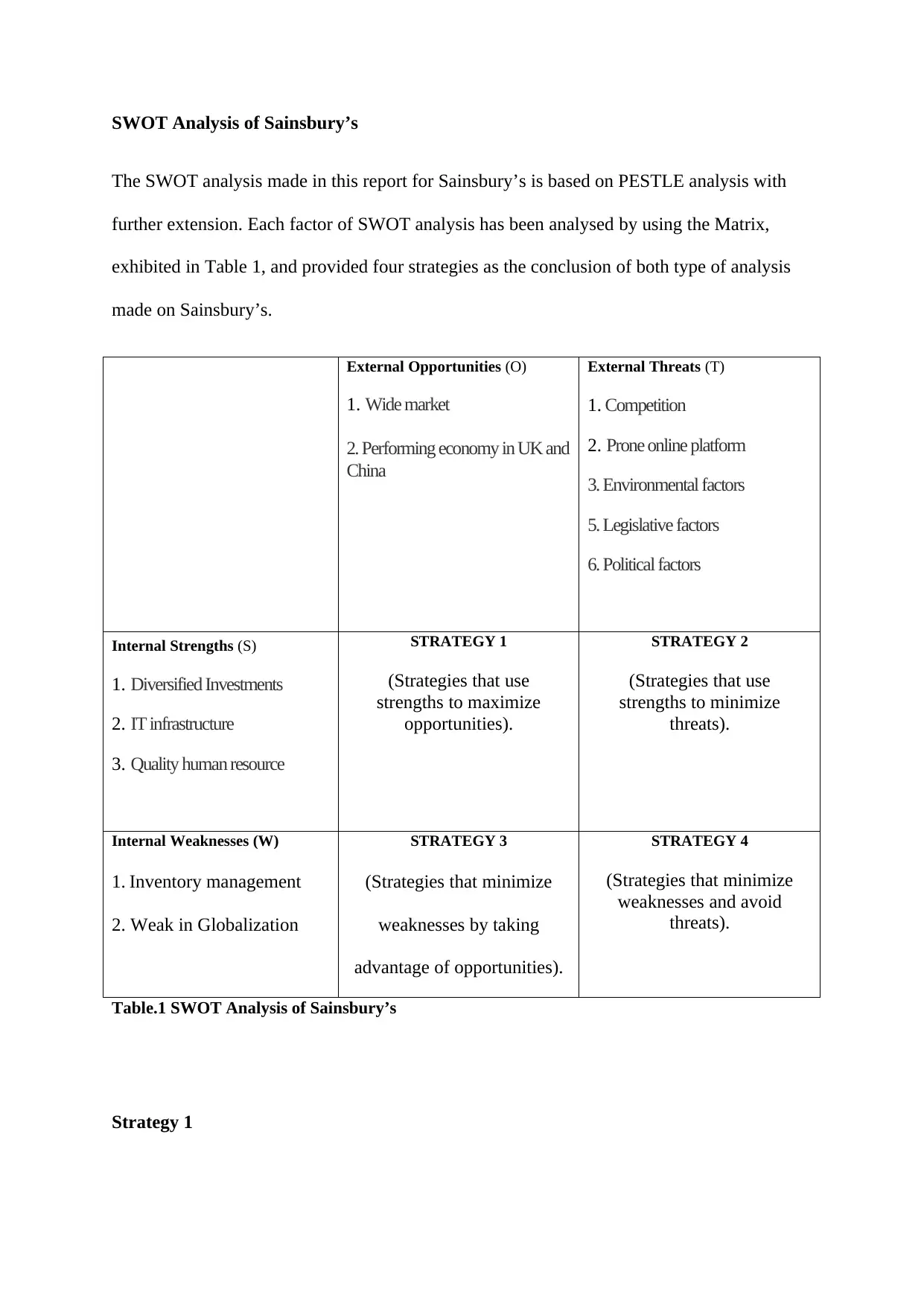
SWOT Analysis of Sainsbury’s
The SWOT analysis made in this report for Sainsbury’s is based on PESTLE analysis with
further extension. Each factor of SWOT analysis has been analysed by using the Matrix,
exhibited in Table 1, and provided four strategies as the conclusion of both type of analysis
made on Sainsbury’s.
External Opportunities (O)
1. Wide market
2. Performing economy in UK and
China
External Threats (T)
1. Competition
2. Prone online platform
3. Environmental factors
5. Legislative factors
6. Political factors
Internal Strengths (S)
1. Diversified Investments
2. IT infrastructure
3. Quality human resource
STRATEGY 1
(Strategies that use
strengths to maximize
opportunities).
STRATEGY 2
(Strategies that use
strengths to minimize
threats).
Internal Weaknesses (W)
1. Inventory management
2. Weak in Globalization
STRATEGY 3
(Strategies that minimize
weaknesses by taking
advantage of opportunities).
STRATEGY 4
(Strategies that minimize
weaknesses and avoid
threats).
Table.1 SWOT Analysis of Sainsbury’s
Strategy 1
The SWOT analysis made in this report for Sainsbury’s is based on PESTLE analysis with
further extension. Each factor of SWOT analysis has been analysed by using the Matrix,
exhibited in Table 1, and provided four strategies as the conclusion of both type of analysis
made on Sainsbury’s.
External Opportunities (O)
1. Wide market
2. Performing economy in UK and
China
External Threats (T)
1. Competition
2. Prone online platform
3. Environmental factors
5. Legislative factors
6. Political factors
Internal Strengths (S)
1. Diversified Investments
2. IT infrastructure
3. Quality human resource
STRATEGY 1
(Strategies that use
strengths to maximize
opportunities).
STRATEGY 2
(Strategies that use
strengths to minimize
threats).
Internal Weaknesses (W)
1. Inventory management
2. Weak in Globalization
STRATEGY 3
(Strategies that minimize
weaknesses by taking
advantage of opportunities).
STRATEGY 4
(Strategies that minimize
weaknesses and avoid
threats).
Table.1 SWOT Analysis of Sainsbury’s
Strategy 1
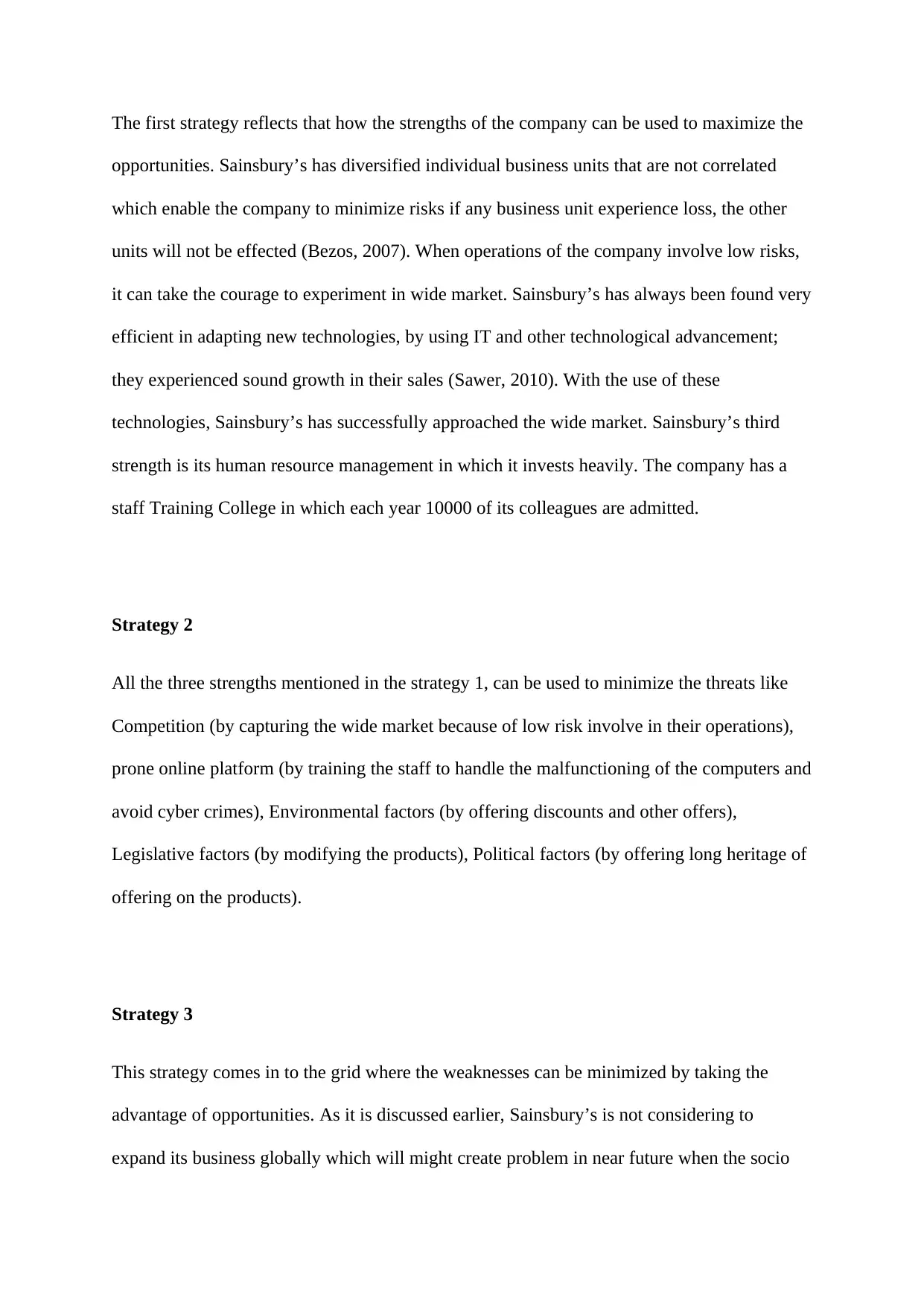
The first strategy reflects that how the strengths of the company can be used to maximize the
opportunities. Sainsbury’s has diversified individual business units that are not correlated
which enable the company to minimize risks if any business unit experience loss, the other
units will not be effected (Bezos, 2007). When operations of the company involve low risks,
it can take the courage to experiment in wide market. Sainsbury’s has always been found very
efficient in adapting new technologies, by using IT and other technological advancement;
they experienced sound growth in their sales (Sawer, 2010). With the use of these
technologies, Sainsbury’s has successfully approached the wide market. Sainsbury’s third
strength is its human resource management in which it invests heavily. The company has a
staff Training College in which each year 10000 of its colleagues are admitted.
Strategy 2
All the three strengths mentioned in the strategy 1, can be used to minimize the threats like
Competition (by capturing the wide market because of low risk involve in their operations),
prone online platform (by training the staff to handle the malfunctioning of the computers and
avoid cyber crimes), Environmental factors (by offering discounts and other offers),
Legislative factors (by modifying the products), Political factors (by offering long heritage of
offering on the products).
Strategy 3
This strategy comes in to the grid where the weaknesses can be minimized by taking the
advantage of opportunities. As it is discussed earlier, Sainsbury’s is not considering to
expand its business globally which will might create problem in near future when the socio
opportunities. Sainsbury’s has diversified individual business units that are not correlated
which enable the company to minimize risks if any business unit experience loss, the other
units will not be effected (Bezos, 2007). When operations of the company involve low risks,
it can take the courage to experiment in wide market. Sainsbury’s has always been found very
efficient in adapting new technologies, by using IT and other technological advancement;
they experienced sound growth in their sales (Sawer, 2010). With the use of these
technologies, Sainsbury’s has successfully approached the wide market. Sainsbury’s third
strength is its human resource management in which it invests heavily. The company has a
staff Training College in which each year 10000 of its colleagues are admitted.
Strategy 2
All the three strengths mentioned in the strategy 1, can be used to minimize the threats like
Competition (by capturing the wide market because of low risk involve in their operations),
prone online platform (by training the staff to handle the malfunctioning of the computers and
avoid cyber crimes), Environmental factors (by offering discounts and other offers),
Legislative factors (by modifying the products), Political factors (by offering long heritage of
offering on the products).
Strategy 3
This strategy comes in to the grid where the weaknesses can be minimized by taking the
advantage of opportunities. As it is discussed earlier, Sainsbury’s is not considering to
expand its business globally which will might create problem in near future when the socio
⊘ This is a preview!⊘
Do you want full access?
Subscribe today to unlock all pages.

Trusted by 1+ million students worldwide
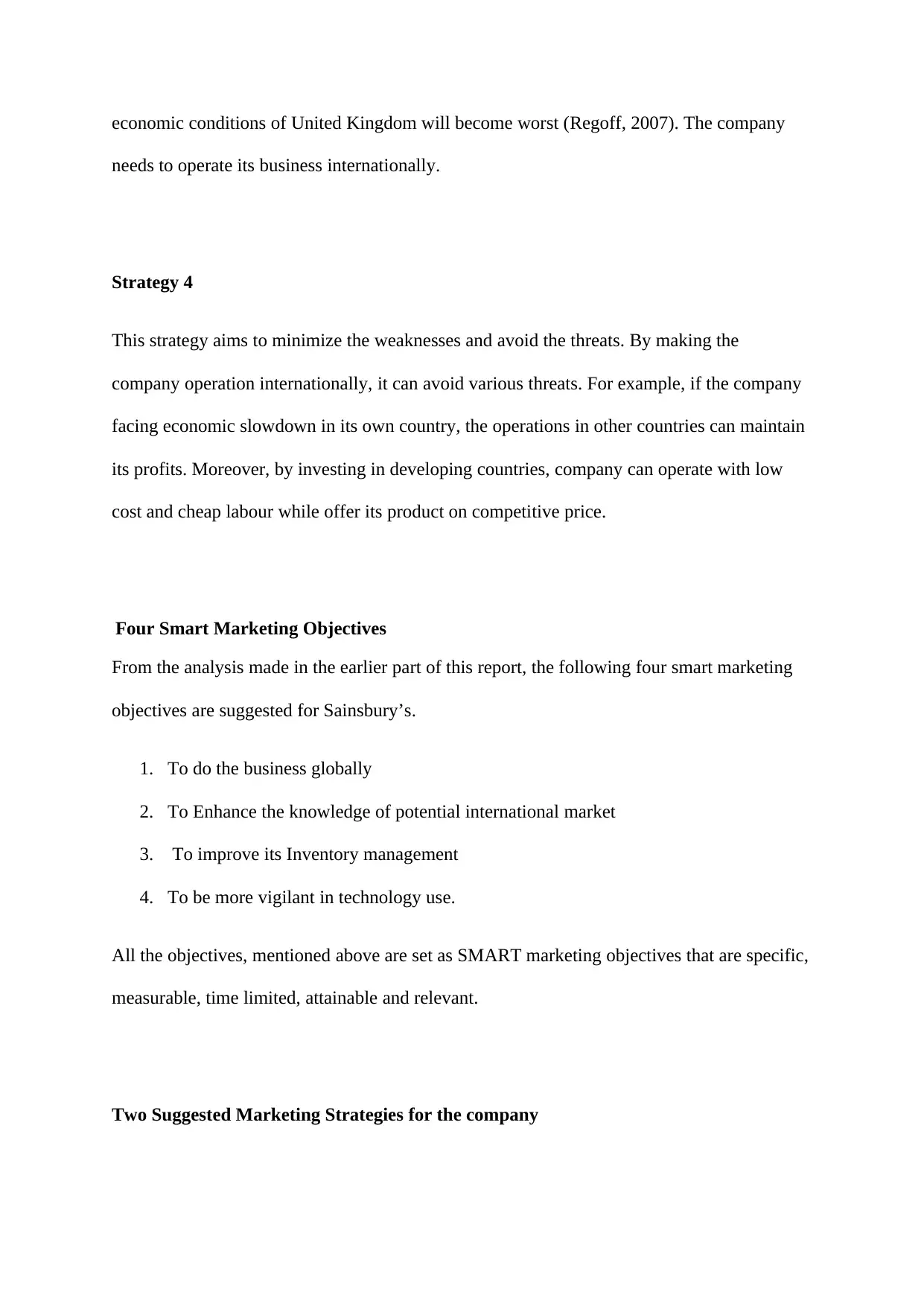
economic conditions of United Kingdom will become worst (Regoff, 2007). The company
needs to operate its business internationally.
Strategy 4
This strategy aims to minimize the weaknesses and avoid the threats. By making the
company operation internationally, it can avoid various threats. For example, if the company
facing economic slowdown in its own country, the operations in other countries can maintain
its profits. Moreover, by investing in developing countries, company can operate with low
cost and cheap labour while offer its product on competitive price.
Four Smart Marketing Objectives
From the analysis made in the earlier part of this report, the following four smart marketing
objectives are suggested for Sainsbury’s.
1. To do the business globally
2. To Enhance the knowledge of potential international market
3. To improve its Inventory management
4. To be more vigilant in technology use.
All the objectives, mentioned above are set as SMART marketing objectives that are specific,
measurable, time limited, attainable and relevant.
Two Suggested Marketing Strategies for the company
needs to operate its business internationally.
Strategy 4
This strategy aims to minimize the weaknesses and avoid the threats. By making the
company operation internationally, it can avoid various threats. For example, if the company
facing economic slowdown in its own country, the operations in other countries can maintain
its profits. Moreover, by investing in developing countries, company can operate with low
cost and cheap labour while offer its product on competitive price.
Four Smart Marketing Objectives
From the analysis made in the earlier part of this report, the following four smart marketing
objectives are suggested for Sainsbury’s.
1. To do the business globally
2. To Enhance the knowledge of potential international market
3. To improve its Inventory management
4. To be more vigilant in technology use.
All the objectives, mentioned above are set as SMART marketing objectives that are specific,
measurable, time limited, attainable and relevant.
Two Suggested Marketing Strategies for the company
Paraphrase This Document
Need a fresh take? Get an instant paraphrase of this document with our AI Paraphraser
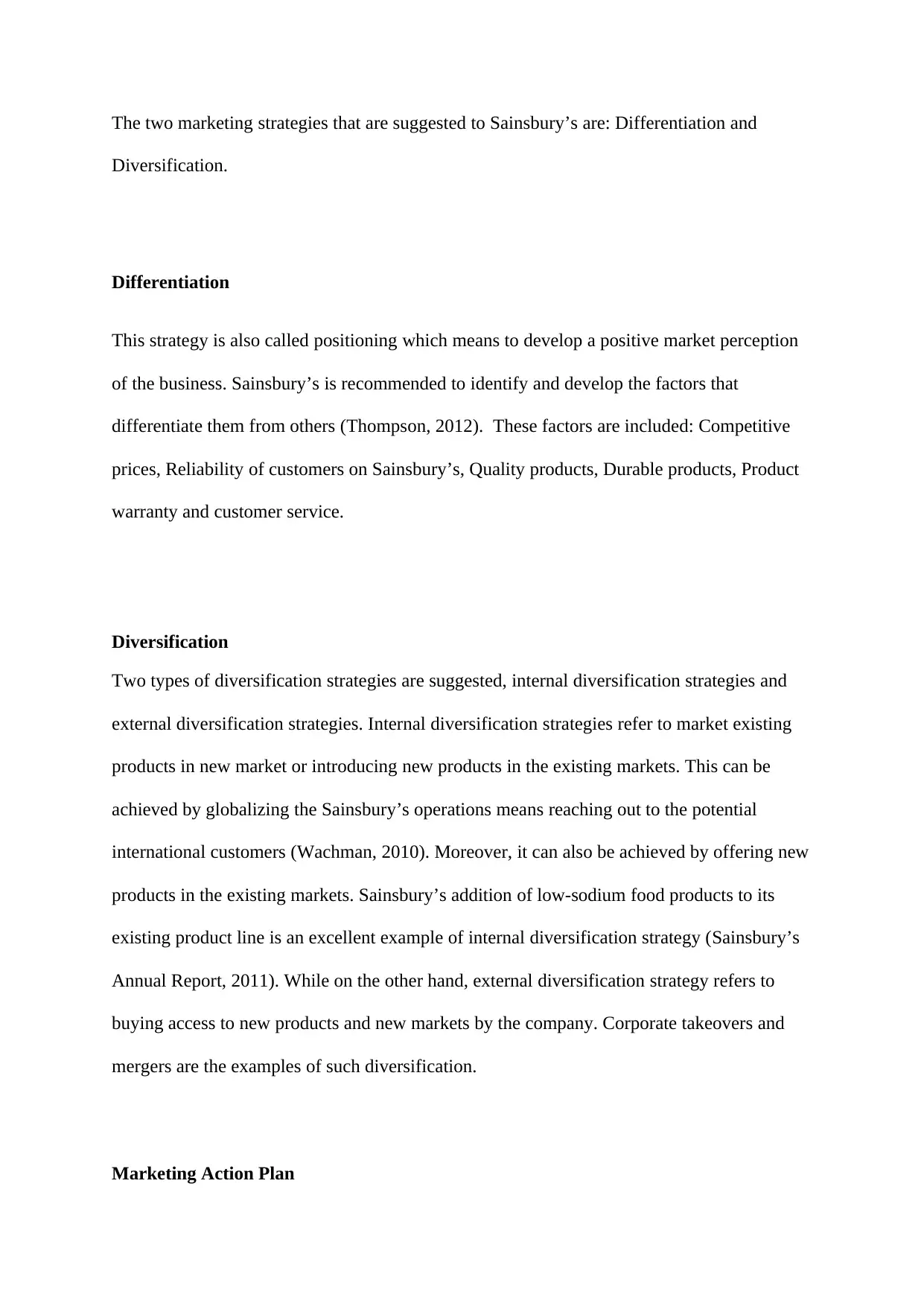
The two marketing strategies that are suggested to Sainsbury’s are: Differentiation and
Diversification.
Differentiation
This strategy is also called positioning which means to develop a positive market perception
of the business. Sainsbury’s is recommended to identify and develop the factors that
differentiate them from others (Thompson, 2012). These factors are included: Competitive
prices, Reliability of customers on Sainsbury’s, Quality products, Durable products, Product
warranty and customer service.
Diversification
Two types of diversification strategies are suggested, internal diversification strategies and
external diversification strategies. Internal diversification strategies refer to market existing
products in new market or introducing new products in the existing markets. This can be
achieved by globalizing the Sainsbury’s operations means reaching out to the potential
international customers (Wachman, 2010). Moreover, it can also be achieved by offering new
products in the existing markets. Sainsbury’s addition of low-sodium food products to its
existing product line is an excellent example of internal diversification strategy (Sainsbury’s
Annual Report, 2011). While on the other hand, external diversification strategy refers to
buying access to new products and new markets by the company. Corporate takeovers and
mergers are the examples of such diversification.
Marketing Action Plan
Diversification.
Differentiation
This strategy is also called positioning which means to develop a positive market perception
of the business. Sainsbury’s is recommended to identify and develop the factors that
differentiate them from others (Thompson, 2012). These factors are included: Competitive
prices, Reliability of customers on Sainsbury’s, Quality products, Durable products, Product
warranty and customer service.
Diversification
Two types of diversification strategies are suggested, internal diversification strategies and
external diversification strategies. Internal diversification strategies refer to market existing
products in new market or introducing new products in the existing markets. This can be
achieved by globalizing the Sainsbury’s operations means reaching out to the potential
international customers (Wachman, 2010). Moreover, it can also be achieved by offering new
products in the existing markets. Sainsbury’s addition of low-sodium food products to its
existing product line is an excellent example of internal diversification strategy (Sainsbury’s
Annual Report, 2011). While on the other hand, external diversification strategy refers to
buying access to new products and new markets by the company. Corporate takeovers and
mergers are the examples of such diversification.
Marketing Action Plan
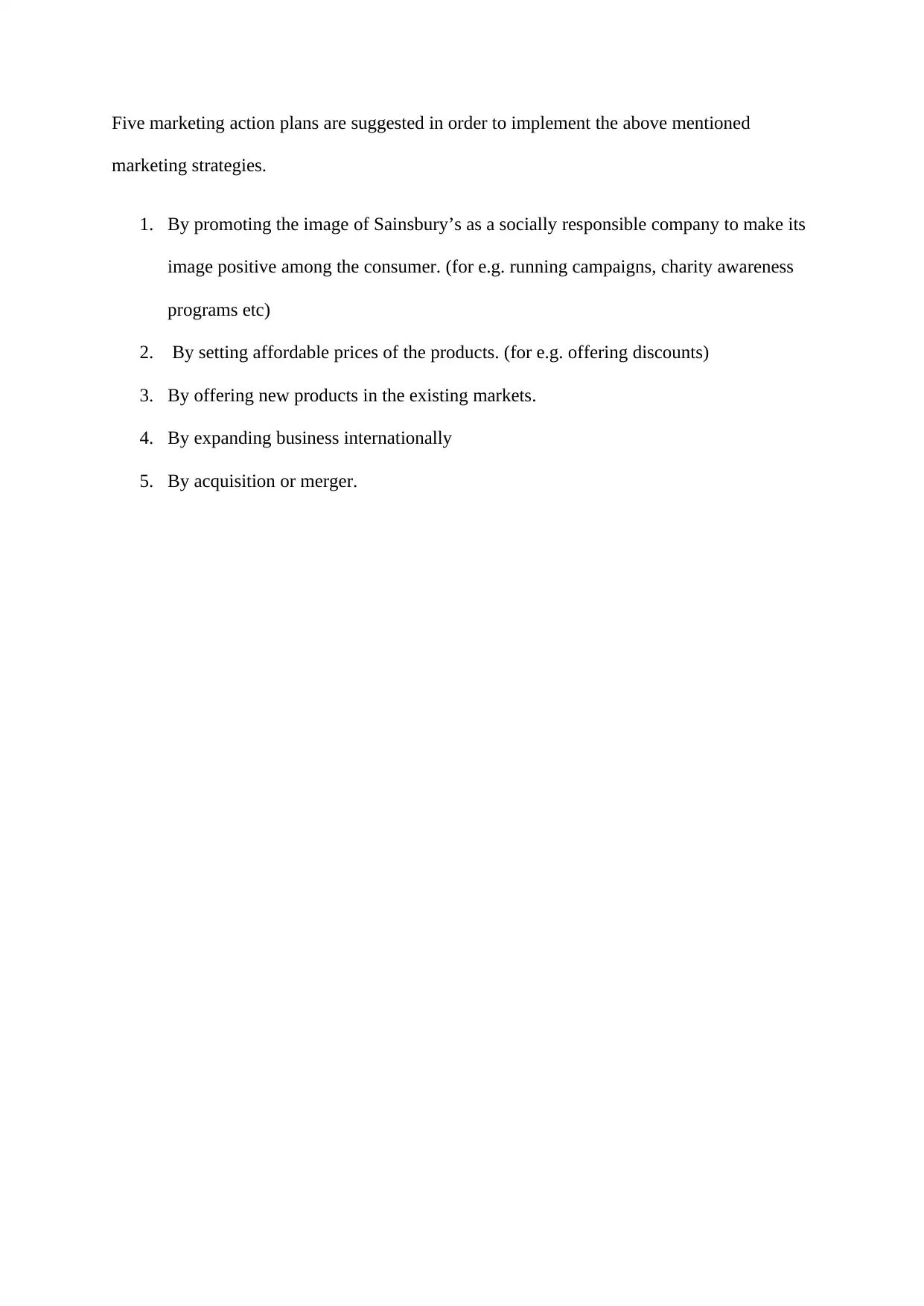
Five marketing action plans are suggested in order to implement the above mentioned
marketing strategies.
1. By promoting the image of Sainsbury’s as a socially responsible company to make its
image positive among the consumer. (for e.g. running campaigns, charity awareness
programs etc)
2. By setting affordable prices of the products. (for e.g. offering discounts)
3. By offering new products in the existing markets.
4. By expanding business internationally
5. By acquisition or merger.
marketing strategies.
1. By promoting the image of Sainsbury’s as a socially responsible company to make its
image positive among the consumer. (for e.g. running campaigns, charity awareness
programs etc)
2. By setting affordable prices of the products. (for e.g. offering discounts)
3. By offering new products in the existing markets.
4. By expanding business internationally
5. By acquisition or merger.
⊘ This is a preview!⊘
Do you want full access?
Subscribe today to unlock all pages.

Trusted by 1+ million students worldwide
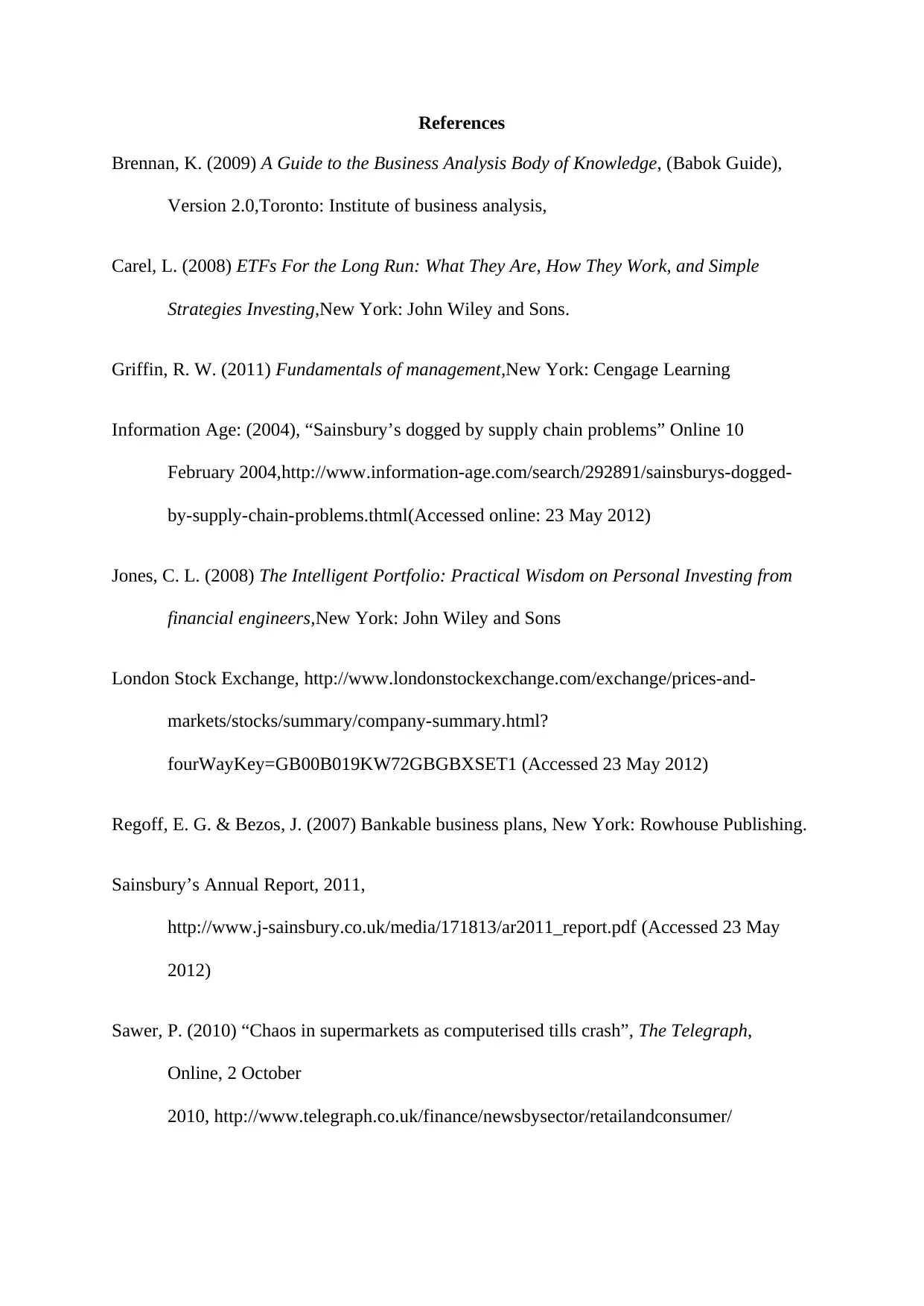
References
Brennan, K. (2009) A Guide to the Business Analysis Body of Knowledge, (Babok Guide),
Version 2.0,Toronto: Institute of business analysis,
Carel, L. (2008) ETFs For the Long Run: What They Are, How They Work, and Simple
Strategies Investing,New York: John Wiley and Sons.
Griffin, R. W. (2011) Fundamentals of management,New York: Cengage Learning
Information Age: (2004), “Sainsbury’s dogged by supply chain problems” Online 10
February 2004,http://www.information-age.com/search/292891/sainsburys-dogged-
by-supply-chain-problems.thtml(Accessed online: 23 May 2012)
Jones, C. L. (2008) The Intelligent Portfolio: Practical Wisdom on Personal Investing from
financial engineers,New York: John Wiley and Sons
London Stock Exchange, http://www.londonstockexchange.com/exchange/prices-and-
markets/stocks/summary/company-summary.html?
fourWayKey=GB00B019KW72GBGBXSET1 (Accessed 23 May 2012)
Regoff, E. G. & Bezos, J. (2007) Bankable business plans, New York: Rowhouse Publishing.
Sainsbury’s Annual Report, 2011,
http://www.j-sainsbury.co.uk/media/171813/ar2011_report.pdf (Accessed 23 May
2012)
Sawer, P. (2010) “Chaos in supermarkets as computerised tills crash”, The Telegraph,
Online, 2 October
2010, http://www.telegraph.co.uk/finance/newsbysector/retailandconsumer/
Brennan, K. (2009) A Guide to the Business Analysis Body of Knowledge, (Babok Guide),
Version 2.0,Toronto: Institute of business analysis,
Carel, L. (2008) ETFs For the Long Run: What They Are, How They Work, and Simple
Strategies Investing,New York: John Wiley and Sons.
Griffin, R. W. (2011) Fundamentals of management,New York: Cengage Learning
Information Age: (2004), “Sainsbury’s dogged by supply chain problems” Online 10
February 2004,http://www.information-age.com/search/292891/sainsburys-dogged-
by-supply-chain-problems.thtml(Accessed online: 23 May 2012)
Jones, C. L. (2008) The Intelligent Portfolio: Practical Wisdom on Personal Investing from
financial engineers,New York: John Wiley and Sons
London Stock Exchange, http://www.londonstockexchange.com/exchange/prices-and-
markets/stocks/summary/company-summary.html?
fourWayKey=GB00B019KW72GBGBXSET1 (Accessed 23 May 2012)
Regoff, E. G. & Bezos, J. (2007) Bankable business plans, New York: Rowhouse Publishing.
Sainsbury’s Annual Report, 2011,
http://www.j-sainsbury.co.uk/media/171813/ar2011_report.pdf (Accessed 23 May
2012)
Sawer, P. (2010) “Chaos in supermarkets as computerised tills crash”, The Telegraph,
Online, 2 October
2010, http://www.telegraph.co.uk/finance/newsbysector/retailandconsumer/
Paraphrase This Document
Need a fresh take? Get an instant paraphrase of this document with our AI Paraphraser
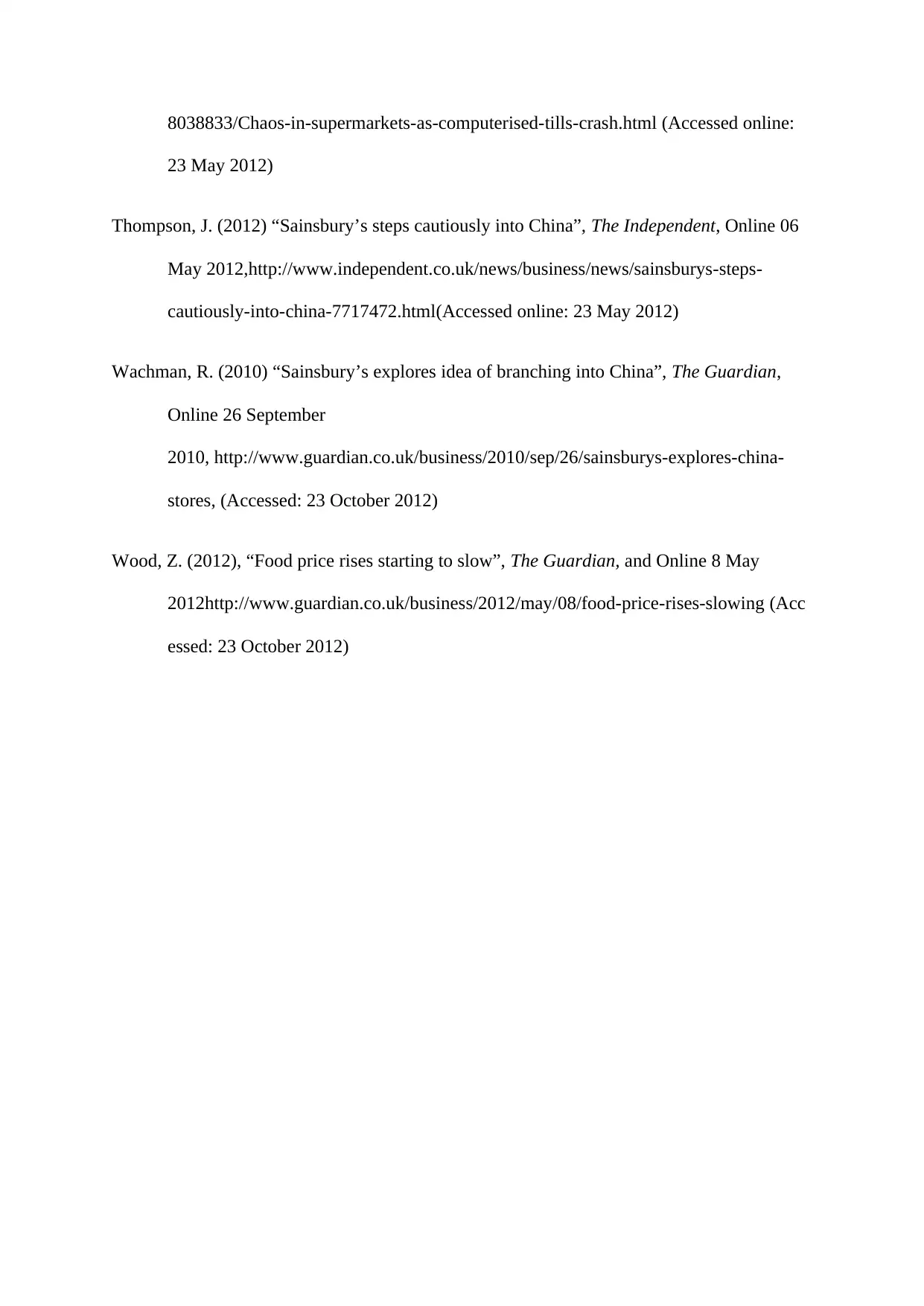
8038833/Chaos-in-supermarkets-as-computerised-tills-crash.html (Accessed online:
23 May 2012)
Thompson, J. (2012) “Sainsbury’s steps cautiously into China”, The Independent, Online 06
May 2012,http://www.independent.co.uk/news/business/news/sainsburys-steps-
cautiously-into-china-7717472.html(Accessed online: 23 May 2012)
Wachman, R. (2010) “Sainsbury’s explores idea of branching into China”, The Guardian,
Online 26 September
2010, http://www.guardian.co.uk/business/2010/sep/26/sainsburys-explores-china-
stores, (Accessed: 23 October 2012)
Wood, Z. (2012), “Food price rises starting to slow”, The Guardian, and Online 8 May
2012http://www.guardian.co.uk/business/2012/may/08/food-price-rises-slowing (Acc
essed: 23 October 2012)
23 May 2012)
Thompson, J. (2012) “Sainsbury’s steps cautiously into China”, The Independent, Online 06
May 2012,http://www.independent.co.uk/news/business/news/sainsburys-steps-
cautiously-into-china-7717472.html(Accessed online: 23 May 2012)
Wachman, R. (2010) “Sainsbury’s explores idea of branching into China”, The Guardian,
Online 26 September
2010, http://www.guardian.co.uk/business/2010/sep/26/sainsburys-explores-china-
stores, (Accessed: 23 October 2012)
Wood, Z. (2012), “Food price rises starting to slow”, The Guardian, and Online 8 May
2012http://www.guardian.co.uk/business/2012/may/08/food-price-rises-slowing (Acc
essed: 23 October 2012)
1 out of 11
Related Documents
Your All-in-One AI-Powered Toolkit for Academic Success.
+13062052269
info@desklib.com
Available 24*7 on WhatsApp / Email
![[object Object]](/_next/static/media/star-bottom.7253800d.svg)
Unlock your academic potential
Copyright © 2020–2025 A2Z Services. All Rights Reserved. Developed and managed by ZUCOL.





